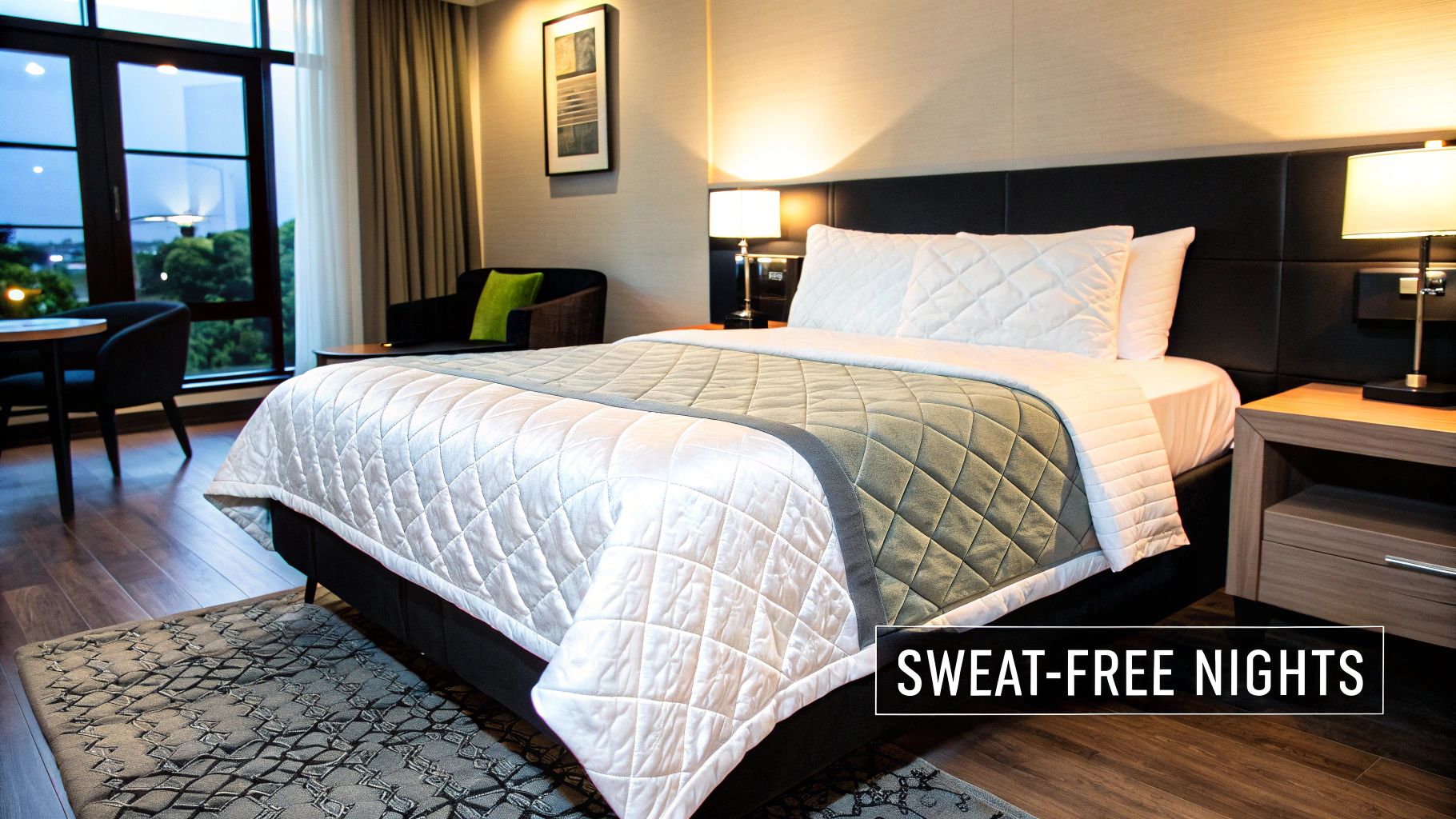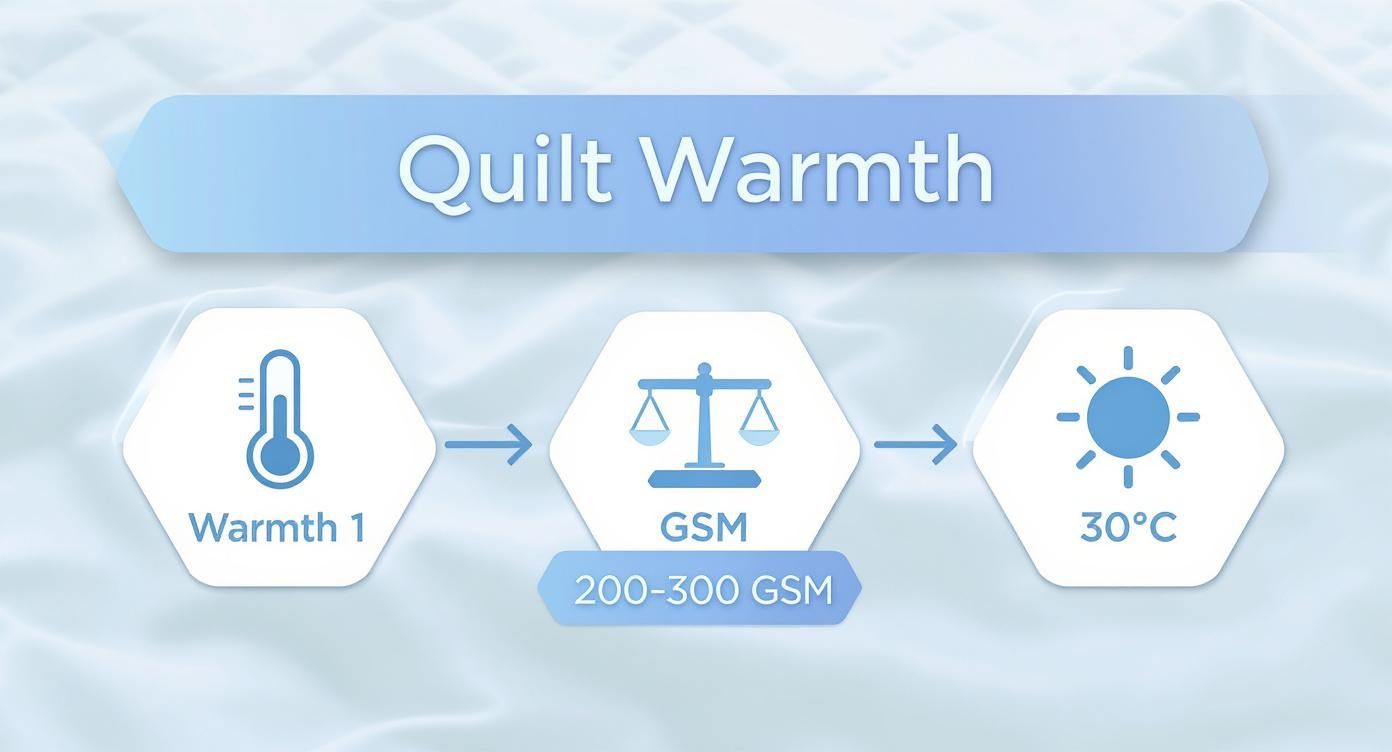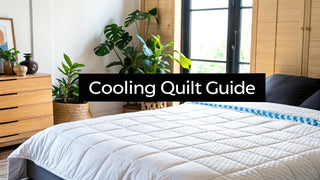Tossing and turning on a hot Australian night, kicking off the covers only to feel cold a few minutes later? If this sounds familiar, a cooling quilt is the simple solution you've been looking for. It offers the comforting weight of a blanket without trapping heat, helping you finally get a full night's sleep when the temperature rises.
Unlike a heavy winter doona, these quilts are specifically designed with breathable materials and a lightweight feel to help your body regulate its temperature naturally. This guide cuts through the marketing fluff to give you clear, actionable advice on finding the perfect one.
Why a Cooling Quilt Is Your Secret to Better Summer Sleep

If you're a naturally hot sleeper, you know the struggle. The constant search for the cool side of the pillow and sweaty wake-ups are exhausting. This is where a cooling quilt makes a real difference.
Instead of trapping body heat like an oven, a cooling quilt promotes airflow. It’s like swapping a thick woolly jumper for a light linen shirt on a sweltering day; you’re simply giving your skin a chance to breathe. This guide will walk you through what actually makes a quilt cool and how to pick the right one for you.
What You Will Learn
We'll get straight to the practical details that lead to a cooler, more comfortable night. We'll cover everything you need to know, including:
- Official Warmth Ratings: How to decipher labels to find a quilt genuinely right for summer.
- Breathable Fabrics: A look at the best materials for wicking away moisture.
- Proper Care Techniques: Easy tips to keep your quilt fresh and effective for years.
Research shows the ideal room temperature for quality sleep is around 18.3°C. A cooling quilt helps your micro-climate—the space right around your body—stay closer to this sweet spot, which can make a huge difference to how well you sleep.
Physical comfort is only one part of the equation. Winding down properly is just as important. To complement your new quilt, you can explore proven ways to wind down before bed for deeper sleep and build a solid evening routine.
Our aim is to arm you with the knowledge to finally win the nightly battle against the heat. To dive right in, have a look at our detailed guide on choosing the best summer quilt tailored for Australian weather.
Understanding Quilt Warmth Ratings for the Aussie Climate
When you're hunting for a cooling quilt, one number cuts through all the marketing noise: the official warmth rating. You wouldn't wear a thick winter jacket in summer, and the same logic applies to your bedding.
For hot sleepers or anyone wrestling with sticky, humid nights, the magic number is Warmth 1. This is the lowest, coolest rating you can get, designed specifically with Aussie summers in mind. Go any higher, and you'll trap too much heat.
What Is a Warmth Rating?
In Australia, quilts are graded on a scale from Warmth 1 (coolest) up to Warmth 7 (warmest). A Warmth 1 quilt is built for those sweltering months when you just need a whisper of a covering to feel comfortable without overheating.
This rating usually goes hand-in-hand with the quilt's weight, measured in grams per square metre (GSM). A lower GSM means a lighter, more breathable quilt that lets air move freely.
Bedding experts in Australia agree that a Warmth 1 quilt will have a weight between 200–300 GSM. This super-light construction is a lifesaver in places like Queensland and Darwin, where summer temps can soar past 30°C and humidity climbs above 70%.
Why Warmth 1 Is the Best Choice for Hot Sleepers
A Warmth 1 quilt gives you just enough weight to feel snug and secure, but without turning your bed into a sauna. It’s the ideal choice if you can't stand sleeping with just a top sheet but find a regular quilt too suffocating.
- Maximum Breathability: The low-density fill lets air circulate, wicking moisture away from your skin.
- Lightweight Comfort: It feels light and airy, so you won't get that heavy, trapped feeling.
- Keeps Your Temperature Just Right: It helps your body maintain a stable temperature, which is key to deep sleep.
Focusing on this specific rating ensures you're buying a product engineered for our warm weather. To get a better sense of how different fills stack up, check out our comparison of wool and down quilts. By looking past the marketing and straight to the official rating, you can make a smarter choice.
The Best Materials for a Truly Cooling Quilt
The fabric touching your skin plays a huge part in how cool you feel all night. Choosing the right material for a cooling quilt isn't just about softness; it’s about finding a fabric that breathes and deals with moisture, stopping that awful clammy feeling.
The best cooling materials let air flow freely, whisking away sweat and helping your body regulate its temperature.
Natural Fibres That Breathe
Natural fibres have been the default choice for staying cool for generations. They're often incredibly breathable and have a light, airy feel that's perfect for a summer quilt.
- Cotton: A timeless classic, cotton is loved for its softness and fantastic airflow. A lightweight cotton lets heat escape easily.
- Linen: Made from the flax plant, linen is exceptionally strong and ridiculously breathable. Its natural moisture-wicking ability is second to none.
This infographic breaks down the key warmth indicators to look for, which ties directly into how these materials perform.

As you can see, the quilt's construction (its GSM) and official warmth rating are just as important as the material itself for cool sleep.
Modern Innovations for Cool Comfort
While natural fibres are fantastic, modern textile technology has given us incredible materials that offer a different kind of cool.
- Bamboo: Known for its luxurious softness and silky feel, bamboo fabric is also highly absorbent. It can wick away three times more moisture than cotton.
- Tencel™ Lyocell: Made from sustainably sourced wood pulp, this fabric is famous for its cool-to-the-touch feel. Research shows it absorbs moisture 50% more effectively than cotton, creating a less friendly environment for bacteria.
To help you decide, here’s a quick comparison of the most common materials.
Cooling Quilt Material Comparison
| Material | Key Benefit | Best For | Care Level |
|---|---|---|---|
| Cotton | Classic breathability and softness | All-round summer comfort and easy maintenance | Low |
| Linen | Exceptional airflow and moisture-wicking | Hot, humid climates and a crisp feel | Medium |
| Bamboo | Silky-smooth feel and high absorbency | Hot sleepers and those who love a soft touch | Low |
| Tencel™ Lyocell | Cool-to-the-touch and superior moisture control | Those wanting advanced cooling and eco-friendly options | Low-Medium |
When you're choosing, think about what "cool" means to you. Is it the crisp, airy feel of linen? Or the slick, chilly touch of Tencel™? Your personal preference is the most important factor.
If you're curious about how different fillings measure up, you can explore our detailed guide on down vs alternative down quilt materials.
How Aussies Have Always Beaten the Heat in Bed
The modern cooling quilt might seem like a recent invention, but the quest for a cool night's sleep is woven into Australia's DNA. Long before we had high-tech fabrics, early Aussies were already masters of staying comfortable through scorching nights.
Early settlers and Indigenous communities knew the secret was airflow. They relied on lightweight cotton coverlets, airy linen sheets, and open-weave blankets—the original arsenal against a sweltering summer.
The core principles haven't changed: breathability and minimal weight.
From Practicality to Performance Fabrics
A heavy woollen blanket, perfect for a freezing English winter, would be useless in the outback. Early bedding choices were driven by necessity. People gravitated towards fabrics that wouldn't trap heat and moisture.
This simple, practical wisdom paved the way for the advanced textiles we enjoy today.
An exhibition at the National Gallery of Victoria, 'Making the Australian Quilt: 1800–1950,' shows this in action. You can see how widely light cottons and linens were used, proving a long-standing tradition of picking materials to suit the climate. This is the historical foundation of what we now call a cooling quilt. You can learn more about these historical textile innovations.
The Journey to Today's Cooling Quilts
The line from a simple cotton sheet to an engineered cooling quilt is a straight one. The goal has always been a comfortable, sweat-free night.
- Then: Bedding was all about natural, lightweight materials like cotton and linen, chosen simply because they felt cooler.
- Now: Modern cooling quilts use scientifically developed materials like bamboo and Tencel™, which actively pull moisture away from your body.
This evolution shows there’s always been a demand for bedding that works with our climate. If you're curious about the nitty-gritty of bedding types, it's worth understanding the difference between a quilt and a duvet.
How to Care for Your Quilt to Keep It Cool
A great cooling quilt is an investment in better sleep, so it makes sense to look after it. Proper care protects the specialised fibres that keep your quilt breathable, ensuring it performs at its best for years.

The good news? Most are designed for easy maintenance. With just a few simple steps, you can keep your quilt feeling fresh and performing brilliantly.
Washing Your Cooling Quilt Correctly
First things first: always check the care label. Most cooling quilts follow similar washing guidelines to preserve their delicate structure.
- Use a Gentle Cycle: Stick to a gentle or delicate cycle with cold water. Hot water can damage the fine fibres essential for breathability.
- Choose a Mild Detergent: A mild, liquid detergent is best. Harsh chemicals can leave a residue that clogs the fabric's pores.
- Wash It Alone: Give your quilt its own space in the machine to prevent snagging and ensure an even clean.
A common mistake is using fabric softener. The waxy residue coats the fibres, ruining their moisture-wicking abilities. It's best to skip it entirely.
For a deeper dive, our guide on how to wash and care for down quilts has extra tips that are handy for many quilt types.
Drying and Storing for Longevity
How you dry your quilt is just as important as how you wash it. Tumble dry on the lowest heat setting. High heat can shrink or damage the fabrics. A great trick is to toss in a few wool dryer balls—they help fluff up the quilt and speed up drying time.
When not in use, store your cooling quilt in a breathable cotton bag in a cool, dry place. Avoid plastic containers, as they trap moisture and can lead to mustiness.
Your Smart Shopping Checklist Before You Buy
Ready to find the perfect cooling quilt? Let's pull everything we've talked about into a simple checklist you can use while shopping.
Think of this as your secret weapon against confusing marketing. It will help you spot the real deal and make a choice you’ll be happy with all summer.
The Cooling Quilt Non-Negotiables
Before you hit "add to cart," make sure any quilt you're considering passes this quick test.
-
Look for the Warmth Rating: This is your most important checkpoint. Scan the label or description for the official 'Warmth 1' rating, the Australian standard for the lightest, coolest quilts.
-
Double-Check the Material: Is the fabric actually breathable? Stick to the proven performers: cotton, linen, bamboo, or Tencel™. These are brilliant at letting air circulate.
-
Read the Care Label: The best cooling quilts are low-maintenance. Look for ones that can be machine washed on a gentle, cold cycle and tumble-dried on low.
A deep dive into sleep quality found our thermal environment is one of the biggest factors affecting rest. Picking the right quilt isn't just a comfort decision; it’s an investment in your health.
Ready to put this checklist to the test? Have a look through our handpicked Summer Bedding Collection, where you'll find plenty of options that meet these exact standards.
If you’re stuck between two popular natural materials, our guide to Linen vs. Cotton will help you decide which one is right for you.
Common Questions About Cooling Quilts
Even after diving into the details, you might still have a few questions about finding the right cooling quilt. To help you feel completely confident, we’ve answered some of the questions we hear most often.
Are Cooling Quilts and Weighted Blankets the Same?
Not at all. A cooling quilt is lightweight and breathable to let heat escape. A weighted blanket is heavy by design to provide deep pressure, which naturally traps heat.
Can I Use a Cooling Quilt in Winter?
This depends on where you live. In a tropical climate like Darwin, a cooling quilt might be all you need year-round. For those in cooler southern spots like Melbourne, a Warmth 1 quilt will likely feel too brisk on a frosty night.
What Is a Reasonable Price?
Prices can swing quite a bit depending on materials. Generally, you can find a quality queen-size quilt made from cotton for between $100 to $180. For premium materials like pure linen or Tencel™, expect to pay in the $200 to $350 range.
Think of it as a long-term investment in your sleep quality. Better sleep has a proven positive impact on your overall health and daily energy.
Do I Need a Top Sheet with a Cooling Quilt?
This is purely personal preference. Using a top sheet is a great way to keep your quilt cleaner for longer. However, some people love the direct, silky feel of a bamboo or Tencel™ quilt cover. If you're curious about layering, our guide on the differences between a quilt and a duvet has some helpful insights.
Ready for Your Best Summer Sleep?
Choosing the right cooling quilt means no more sweaty, restless nights. By focusing on a Warmth 1 rating and breathable fabrics like cotton or bamboo, you can create the perfect sleep environment. It's a simple change that makes a huge difference to your comfort and health.
Ready to end the nightly battle with the heat and wake up feeling refreshed? The team at Sienna Living has put together a collection of premium cooling quilts, specifically chosen to deliver exceptional comfort for Australian sleepers.
Explore the Sienna Living collection and find your perfect cooling quilt today!

